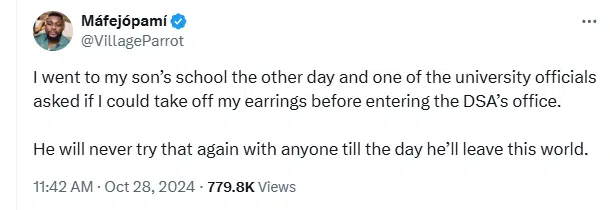A father’s visit to his son’s university turned contentious when he was asked to remove his earrings before entering the Division of Student Affairs (DSA) office. The parent, known on social media platform X as @VillageParrot, has shared his experience, highlighting growing tensions between traditional institutional norms and changing social attitudes.
The confrontation, which has since gained significant attention on social media, sheds light on the complex dynamics between younger parents and traditional academic institutions. According to the father’s account, the request to remove his earrings prompted a forceful response that he claims will leave a lasting impression on the university official involved.
The incident takes on additional significance as the parent revealed a history of being misidentified at the institution. In a follow-up post, he explained that his youthful appearance had previously led university staff to question his status as a parent, with some assuming he was using his connection to a male student as a pretext for visiting female students on campus.
This misidentification points to broader issues of age bias and stereotyping within educational institutions, where younger parents often face additional scrutiny or skepticism. The parent noted that these assumptions had led to a “serious issue” in the past, suggesting an ongoing pattern of challenging interactions with the institution’s staff.
The incident raises important questions about the balance between institutional decorum and personal freedom of expression. While universities traditionally maintain certain standards of dress and appearance, the evolving nature of social norms and personal expression has begun to challenge these long-standing policies. The clash between generational perspectives becomes particularly apparent when younger parents, who may have different views on self-expression, interact with more traditional institutional structures.
The parent’s strong reaction to the earring request highlights the emotional impact of such policies on individuals who feel their personal identity is being unnecessarily policed. His assertion that the official “will never try that again with anyone till the day he’ll leave this world” suggests a confrontation that may have broader implications for how the institution handles similar situations in the future.
The social media response to this incident has been mixed, with some supporters defending the right to personal expression and others questioning the appropriate boundaries of institutional dress codes. The discussion has expanded beyond the specific incident to encompass broader debates about modernizing educational institutions’ policies to reflect contemporary social norms.
This situation also underscores the changing demographics of university parents and the need for institutions to adapt their approaches accordingly. As younger parents become more common in academic settings, traditional assumptions about parental appearance and behavior may need to be reconsidered to prevent unnecessary conflicts and misunderstandings.
The incident serves as a reminder of the ongoing tension between individual expression and institutional norms in educational settings. As society continues to evolve, universities face the challenge of maintaining professional standards while accommodating changing social attitudes toward personal appearance and self-expression.
The parent’s experience has sparked important conversations about discrimination based on appearance and age, particularly in formal educational settings. It raises questions about whether traditional dress codes and appearance policies need to be reevaluated to better reflect contemporary society while still maintaining appropriate professional standards.
Looking forward, this incident may prompt educational institutions to review their policies regarding visitor appearance and consider more inclusive approaches that respect diverse forms of personal expression. The strong reaction from the parent and the subsequent social media attention suggest that such incidents are likely to continue challenging traditional institutional norms.
As educational institutions continue to evolve, finding the right balance between maintaining professional standards and respecting personal expression remains a crucial challenge. This incident serves as a catalyst for broader discussions about modernizing institutional policies while ensuring they remain respectful of diverse perspectives and changing social norms.




